Cinnamon Winter Beach Beauty
By Miya Lucas
The Marbled Godwit is one of my favorite birds and one you can easily identify walking on a beach on a winter day in the Bay Area. Marbled Godwits are large, beautiful orange colored birds, easy to spot on the shoreline. They stand 18 inches tall, with long gray legs and their extended pencil-thin, bi-colored beak makes them easy to see. They are the largest of all the godwits. (Black-tailed Godwit, Bar-tailed Godwit, Hudsonian Godwit)
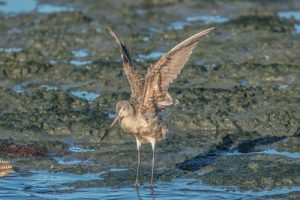
It is unclear how the Marbled Godwit obtained it’s name. The “Marbled” part is easy to understand and it’s a good description of their tawny coloring, but the second part, “Godwit” is a mystery. From what I can gather, in Old English, god meant good, and wit or wiht, meant creature. In Spanish, they are called cinnamon needle, Aguja Canela.
The Marbled Godwit seems fearless to me, I call them the gentle giant of the shoreline beaches. They seen unaffected by the often frenzy flights by the smaller shorebirds, sometimes hundreds of them who fly away – startled by who knows what – then readily return to continue forging on the shoreline. Meanwhile, the Marbled Godwits, stand their ground and just continue feeding, grooming or sleeping.
The Marbled Godwits are social birds. Except for breeding season, you rarely see just one Marbled Godwit. They fly in flocks and will feed in flocks. With a one syllable high pitched call, they will let the group know if one is leaving or arriving. Their long elegant lines are often juxtaposed to their call, they have an annoying high pitch loud erking sound almost like a two year old ready to throw a tantrum.
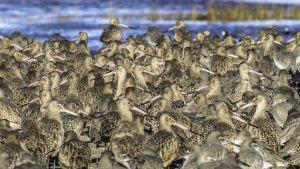
Both sexes look alike, both have the bi-colored bills, pink at the base with a black end. However, the females have a bill about 2cm longer than the male. Also, the female weighs about 20% more than the male. Sometimes, if you are an astute observer, in early August you may see the Marbled Godwit in it’s breeding plumage. During breeding season, the male’s bi-colored bill becomes more orange in color, although the black outermost tip remains the same, and the breast will be more barred.
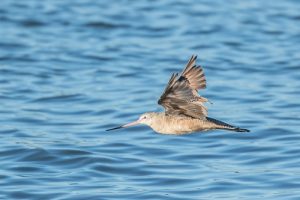
The Marbled Godwit spends the winter along most of the Western or Eastern American shoreline, including Central America. Marbled Godwits breed in the continental US in Montana and the Dakotas and in the Canadian provinces of Alberta, Saskatchewan and Manitoba. Outside of the continental US they also breed in the northern part of Alaska. The Marbled Godwit has a short migration period between breeding and flying to their winter grounds. Many other shorebirds like the Hudson Godwit breed in the Arctic Tundra and fly down to farthest the tip of South America for the winter.
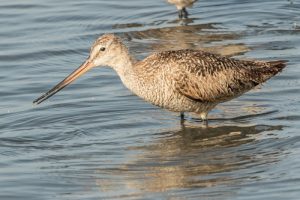
The Marbled Godwit is made up of sub-species, Limosa fedoa and limosa fedoa beringiae. They look alike, but limosa fedoa berginiae breeds in the northern most part of Alaska,has shorter wings, and weighs more than the limosa fedoa.
As you might expect, their diet changes once they are on their winter grounds. Forging on the coastlines, it’s no surprise that they enjoy a seafood diet composed of crabs and marine worms, also known as polychaetes. When they forge, it is common to see them dip, not just their beaks , but their whole head into the sand. When they are breeding, their diet is made up of grasshoppers, insects, aquatic tubers, leeches and sometimes small fish.
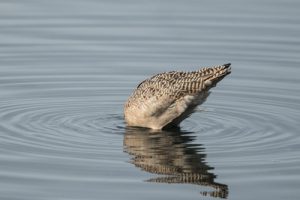
The Marbled Godwit’s courtship involves two different rituals. One is on the ground, the male will chase the female. The male will posture and when he gets close to the desired female he will gently nip at her neck. The other type of ritual involves flying. The male will fly slowly in circles calling to his desired female.
During breeding season, Marbled Godwits are monogamous, and both will assist with incubation and brooding their four chicks, only brooding once a season. Marbled Godwits do not feed, nor carry their young chicks. On the first day of the chick’s life their eyes are open, they are walking and feeding themselves, and will leave the nest in 1-2 days. The female parent will leave the nest in about 2 weeks, and the male parent usually stays with the chicks up to three weeks. The oldest Marbled Godwit lived 25 years and was discovered during one of the banding sessions in Humboldt Bay in 1969. Typically, their documented average lifespan is about 13 years.

Their numbers have remained stable since 1966. They are considered a watch concern by the North American Breeding Bird Survey. There is always a concern for the loss of both wintering grounds and breeding prairie grounds.
The Marble Godwit spends about 7-8 months with us every year. I hope you get a chance to see them this winter. I like to see them at Alameda’s shoreline, however you can find them on almost any beach in the San Francisco Bay Area. l especially enjoy watching them spread their 30 inch wingspan. That’s when you can see their beautiful marbled colors, which can lighten up any weary rainy winter day.
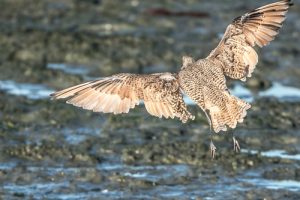
Miya Lucas frequently leads walks with co leader Wendy Beers at Las Gallinas Storage Ponds, when she’s not otherwise trying to photograph birds. The team will also lead a Birdathon fundraising trip for GGBA to Garin Regional Park in April. Go to https://goldengatebirdalliance.org/birdathon-2019-fundraising-trips/ for more info.
